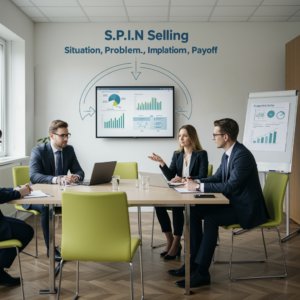The S.P.I.N Selling method is one of the most effective sales techniques for improving team performance and increasing deal closure rates. It focuses on understanding customer needs, identifying their pain points, creating urgency, and presenting a tailored solution. The method is built on four key stages: Situation, Problem, Implication, and Need-Payoff.
Implementing S.P.I.N Selling in your sales team can lead to higher conversion rates, improved customer satisfaction, and stronger brand loyalty. In this article, we’ll explore how to effectively train sales teams to master S.P.I.N Selling and become top-performing sales professionals.
Step 1: Understanding the Fundamentals of S.P.I.N Selling
Before training a sales team to master S.P.I.N Selling, it’s crucial to ensure they grasp the fundamental principles of the method. This training should include:
- Theoretical Overview – A detailed explanation of each of the four S.P.I.N stages.
- Practical Examples – Real-life case studies demonstrating successful applications of the method.
- Comparison with Traditional Sales Techniques – Highlighting how S.P.I.N Selling differs from and improves upon conventional sales approaches.
Once sales reps understand how targeted questions can uncover a customer’s real needs, they develop a more consultative and tailored approach, leading to higher closing rates and better customer relationships.
Step 2: Developing Effective Questioning Techniques
At the core of S.P.I.N Selling is the ability to ask the right questions at the right time during the sales process. Sales teams need to know how to structure their questions according to the four S.P.I.N stages:
- Situation Questions – Help understand the customer’s current state. Example: “How do you currently manage this process?”
- Problem Questions – Identify challenges and pain points. Example: “What difficulties are you facing with your current solution?”
- Implication Questions – Highlight the negative impact of the problem. Example: “How are these challenges affecting your company’s efficiency and revenue?”
- Need-Payoff Questions – Emphasize the benefits of solving the problem. Example: “If we could provide a solution that cuts your costs by 20%, how would that impact your business?”
Practical training should include role-playing exercises and workshops where sales reps practice these questioning techniques in real sales scenarios.
Step 3: Active Listening and Building Customer Trust
Mastering S.P.I.N Selling isn’t just about asking great questions—it’s also about listening actively and demonstrating a deep understanding of the customer’s needs.
Active listening involves:
- Giving full attention to the customer without interruptions.
- Using reflective listening – Repeating or rephrasing what the customer has said to confirm understanding.
- Asking clarifying questions – Encouraging customers to elaborate and providing deeper insights.
When sales reps show that they truly understand a customer’s pain points and concerns, it builds trust and strengthens the relationship, increasing the likelihood of closing the deal.
Step 4: Focusing on Value Rather Than Just Selling
Instead of aggressively pushing a product or service, S.P.I.N Selling focuses on delivering real value to the customer. Sales professionals trained in this method shift from a “hard sell” approach to a customer-centric sales strategy by:
- Presenting Data and Proven Results – Using case studies, research, and testimonials to support claims.
- Leveraging Customer Success Stories – Sharing real-life examples of how similar businesses benefited from the solution.
- Customizing the Sales Pitch – Tailoring the presentation to align with the specific needs and pain points of each customer.
By highlighting the impact and value rather than just product features, sales reps can position themselves as trusted advisors rather than just salespeople.
Step 5: Continuous Training and Skill Development
Training sales teams in S.P.I.N Selling isn’t a one-time event—it requires ongoing practice, feedback, and improvement. Key strategies for continuous skill development include:
- Sales Simulations – Practicing different scenarios to enhance adaptability.
- Deal Analysis and Post-Sale Reviews – Evaluating past sales conversations to identify areas for improvement.
- Learning from Successes and Failures – Encouraging team members to share experiences and best practices.
Regular training and reinforcement ensure that sales reps stay sharp, refine their techniques, and consistently improve their performance.
Conclusion: How S.P.I.N Selling Can Transform Your Sales Team
Training sales teams to master S.P.I.N Selling is a long-term investment that delivers measurable results. By combining in-depth learning, practical application, active listening, value-driven selling, and continuous improvement, businesses can cultivate high-performing sales teams that close more deals and build lasting customer relationships.
Implementing this method effectively will help your company increase revenue, improve customer satisfaction, and enhance brand loyalty. Now is the time to take your sales team to the next level and start leveraging the power of S.P.I.N Selling to achieve greater success.









